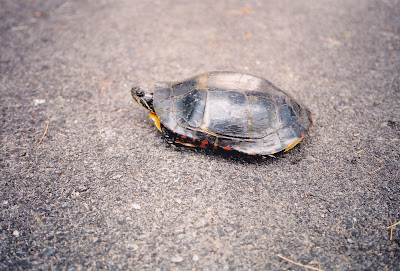 |
| A turtle in the road. |
It happens every spring. I am driving down the road late in the afternoon and I see a small dark object ahead of me, right in the middle of my lane. As I approach, I note that the object is moving, ever-so-slowly, toward the side of the road. In order to pass around it, I must stop and wait for a break in the oncoming traffic. Thus every spring I spend a few seconds — maybe even a minute if the traffic is heavy — observing the female turtle en route to her nesting site.
Turtles have been around since before the dinosaurs. Remember the “Tortoise and Hare” story? The turtle definitely had it right, because it’s still here, poking along, slowly but surely through the ages. And turtles tend to stay around for a long time. Their lifespan is remarkable among not only other reptiles, but among most fish, birds, and mammals. It is not uncommon for a small turtle to live from 20 to 50 years. A large sea turtle may live 100 years or more.
There are two turtle families found regularly in this region. The Emydidae family, which includes the box turtle, painted turtle, and pond slider, can be found in ponds, marshes, and other semiaquatic areas. Snapping (Chelydridae) turtles live in marshes, large lakes, reservoirs and rivers, in suburban and even urban settings. Both varieties eat both plants and animals.
When they’re not obstructing traffic, turtles can often be seen sunning themselves on rocks and logs. Not unlike humans, turtles like to bask in the sun. But turtles do it for a reason other than to relax or get a tan.The theory is that basking permits turtles to raise their body temperatures to a level where they can most efficiently move, escape predators, digest food, and complete other bodily functions. The heat of the sun also helps turtles to rid their bodies and shells of algae, leeches, and parasites.
So why did the turtle cross the road? Most likely to lay her eggs. The painted turtle likes to make her nest in sandy soils such as gravel pits, roadsides, and railroad beds, or on lawns or mowed fields. One to two months after a mid-spring courtship, the female painted turtle will begin looking for a nesting site. Typically stepping out in the late afternoon, she will seek a open, sunny spot with vegetation nearby. She will dig several false and one true nest (to confuse predators) and then deposit 4 – 8 small, white or yellowish oblong eggs. She’ll neatly cover up the nest, and then it’s back to the pond. If the skunks, foxes, squirrels, and raccoons don’t find them, the eggs will hatch in late summer, and once they’re strong enough, the hatchlings will migrate to a pond or river.
Snapping turtles, by far the most common in these parts, also nest in mid-spring and early summer. Snappers favor many of the same nesting areas as painted turtles, however they also like beaches, dunes, and the shores of ponds and lakes. Snapping turtles love the water so much that just about the only time they’ll leave it is to move to another pond or to make a nest. The female snapping turtle typically deposits 20 – 30 eggs at a nesting; the eggs are round and a bit smaller than a ping pong ball. Finding a snapper’s nest can be easy, because they’re a bit sloppy when it comes to hiding them. It’s no wonder then, that the nests are often raided by skunks and other critters, usually within the 24 hours after the eggs are lain. The hatchlings emerge in August or September, and eventually migrate to shallow water.
So the next time you’re driving along and a slow-moving turtle blocks your path, be considerate. She’s moving as fast as she can. Let her pass so she can lay her eggs and get back to her favorite log in the sun. And don’t be surprised if you see her again next year.
by Kezia Bacon
May 1996
Kezia Bacon of Marshfield is the Assistant Director of the North and South Rivers Watershed Association.
